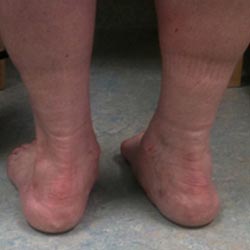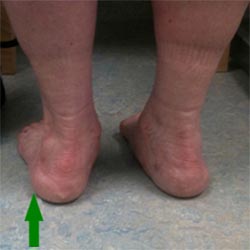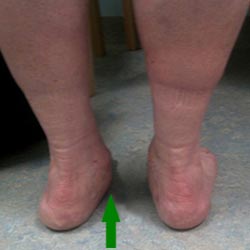 What is a “Flat Foot”?
What is a “Flat Foot”?
A flat foot is exactly as it suggests, on the inner aspect of the foot there is normally an arch stretching from the heel to the base of the toes. This arch develops through childhood, the height of the arch varying amongst individuals. Some people never develop a medial arch and others may develop one and later the arch gradually flattens.
Why do they develop?
If the arch never develops, this may be caused by a link between the bones of the foot (a coalition see below), in other people the arch starts to collapse during adulthood often due to failure of the tendon that supports the arch (tibialis posterior tendinopathy).
What symptoms does it cause?
Pain: If a coalition is present this in itself often does not cause any problem, however it may lead to pain following an ankle sprain in a teenager

Heel angles so more toes are seen from the back than normal, the so-called ‘too many toes sign’
If the flat foot is developing due to tibialis posterior tendinopathy then often pain occurs behind the inner aspect of the ankle before the arch starts to drop. Once the foot has become flat pain may develop on the outer aspect of the ankle where soft tissue becomes trapped between the side of the heel bone (calcaneus) and the thinner bone on the outside of the leg (fibula). If the foot remains flat and unsupported it can lead to arthritis in the ankle joint.
Change in foot shape: In the case of tibialis posterior tendon dysfunction the medial arch of the foot gradually flattens, thus “flat foot”.
Instability (Giving way) It may feel as if the foot/ ankle is going to or does actually give way, this may occur due to pain, but may also occur because the failure of the tibialis posterior tendon as it loses the ability to support the medial arch of the foot.
What options are there for treatment?
a. Supportive shoes
Supportive shoes particularly those with a good supportive arch and laces often help.
b. Orthotics (Insoles)
These can be of benefit in the adult flat foot caused by tibialis posterior tendinopathy. It is possible to buy them over the counter, however custom made orthotics fitted by a podiatrist are likely to be more effective, thinner and fit more easily into shoes.

Loss of medial arch
There is no significant evidence at present to suggest that the use of orthotics is beneficial in children with asymptomatic flexible flat feet.
c. Physiotherapy
Physiotherapy strengthening and stretching exercises can be useful in flat feet where the cause is tibialis posterior tendonpathy.
d. Pain relieving medication
These can help, however it is important to remember that they can interact with other medication that you are taking and you may need to check with your doctor, which you can take.
e. Surgery
This is generally of three types:
i. Tibialis posterior tendon reconstruction
The tendon that bends your lesser toes (i.e. not the big toe) can be used to replace the tibialis posterior tendon to support the arch of your foot; this is possible as there is a usually link (if not one can be created) between the tendon that bends the big toe and the one that bends the lesser toes, so even when the tendon to the lesser toes is used to replace the tibialis posterior tendon, it is still be possible to bend the lesser toes. (To prove this try to just bend your big toe now without bending the lesser toes).
This reconstruction usually requires by the adjusting the position of one or more of the bones in the foot by cutting and resetting them: osteotomies.
For more information see: FDL Tendon Transfer.
ii. Triple Arthodesis
This is required if the deformity is severe, if the joints have become very stiff or arthritis has developed in the joints below and around the ankle. See: Triple Arthodesis.
iii. Excision of Tarsal Coalition
This is performed if there is a coalition present that has become painful and has not settled with non-operative management.
As mentioned above if the deformity has been present for a significant length of time then arthritis may develop in the ankle, for more information on this please see: Ankle Arthritis.
